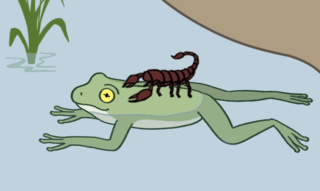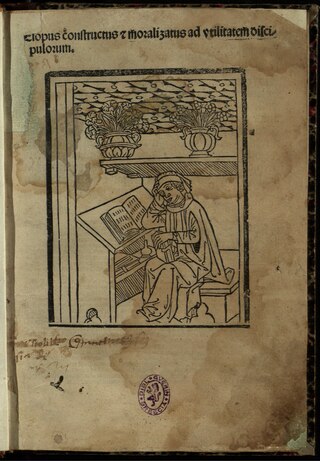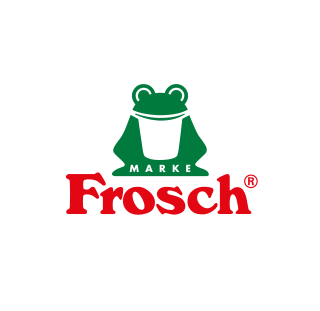
Rana rupta et bos (The Frog that exploded, and the ox) is a Latin retelling from the Liber primus of the Fabulae (1:24) of the Roman poet Phaedrus (1st century); the Latin text is itself based on The Frog and the Ox, one of Aesop's Fables. [1]

Rana rupta et bos (The Frog that exploded, and the ox) is a Latin retelling from the Liber primus of the Fabulae (1:24) of the Roman poet Phaedrus (1st century); the Latin text is itself based on The Frog and the Ox, one of Aesop's Fables. [1]
| Latin original | Poetic free translation by Henry Thomas Riley | Literal translation by Christopher Smart | Interpretation |
|---|---|---|---|
Rana rupta et bos | The Proud Frog | The needy man, while affecting to imitate | The fable teaches that one should |

Fable is a literary genre defined as a succinct fictional story, in prose or verse, that features animals, legendary creatures, plants, inanimate objects, or forces of nature that are anthropomorphized, and that illustrates or leads to a particular moral lesson, which may at the end be added explicitly as a concise maxim or saying.

Gaius Julius Phaedrus, or Phaeder was a 1st-century AD Roman fabulist and the first versifier of a collection of Aesop's fables into Latin. Nothing is recorded of his life except for what can be inferred from his poems, and there was little mention of his work during late antiquity. It was not until the discovery of a few imperfect manuscripts during and following the Renaissance that his importance emerged, both as an author and in the transmission of the fables.

Aesop's Fables, or the Aesopica, is a collection of fables credited to Aesop, a slave and storyteller who lived in ancient Greece between 620 and 564 BCE. Of varied and unclear origins, the stories associated with his name have descended to modern times through a number of sources and continue to be reinterpreted in different verbal registers and in popular as well as artistic media.

The Fox and the Grapes is one of Aesop's Fables, numbered 15 in the Perry Index. The narration is concise and subsequent retellings have often been equally so. The story concerns a fox that tries to eat grapes from a vine but cannot reach them. Rather than admit defeat, he states they are undesirable. The expression "sour grapes" originated from this fable.

The Frog and the Ox appears among Aesop's Fables and is numbered 376 in the Perry Index. The story concerns a frog that tries to inflate itself to the size of an ox, but bursts in the attempt. It has usually been applied to socio-economic relations.
The Frogs Who Desired a King is one of Aesop's Fables and numbered 44 in the Perry Index. Throughout its history, the story has been given a political application.

The Scorpion and the Frog is an animal fable which teaches that vicious people cannot resist hurting others even when it is not in their own interests. This fable seems to have emerged in Russia in the early 20th century.

The Fox and the Crow is one of Aesop's Fables, numbered 124 in the Perry Index. There are early Latin and Greek versions and the fable may even have been portrayed on an ancient Greek vase. The story is used as a warning against listening to flattery.

The Tortoise and the Birds is a fable of probable folk origin, early versions of which are found in both India and Greece. There are also African variants. The moral lessons to be learned from these differ and depend on the context in which they are told.

Gualterus Anglicus was an Anglo-Norman poet and scribe who produced a seminal version of Aesop's Fables around the year 1175.
Romulus is the author, now considered a legendary figure, of versions of Aesop's Fables in Latin. These were passed down in Western Europe, and became important school texts, for early education. Romulus is supposed to have lived in the 5th century.

Aesop was a Greek fabulist and storyteller credited with a number of fables now collectively known as Aesop's Fables. Although his existence remains unclear and no writings by him survive, numerous tales credited to him were gathered across the centuries and in many languages in a storytelling tradition that continues to this day. Many of the tales associated with him are characterized by anthropomorphic animal characters.
In Classical mythology, Dolus is a figure who appears in an Aesopic fable by the Roman fabulist Gaius Julius Phaedrus, where he is an apprentice of the Titan Prometheus. According to the Roman mythographer Hyginus, Dolus was the offspring of Aether and Terra (Earth), while Cicero has Dolus being the offspring of Aether and Dies (Day).

The Mountain in Labour is one of Aesop's Fables and appears as number 520 in the Perry Index. The story became proverbial in Classical times and was applied to a variety of situations. It refers to speech acts which promise much but deliver little, especially in literary and political contexts. In more modern times the satirical intention behind the fable was given greater emphasis following Jean de la Fontaine's interpretation of it. Illustrations to the text underlined its ironical application particularly and went on to influence cartoons referring to the fable elsewhere in Europe and America.

The Frog and the Mouse is one of Aesop's Fables and exists in several versions. It is numbered 384 in the Perry Index. There are also Eastern versions of uncertain origin which are classified as Aarne-Thompson type 278, concerning unnatural relationships. The stories make the point that the treacherous are destroyed by their own actions.
Hildegard Ochse was a German photographer.
There are no less than six fables concerning an impertinent insect, which is taken in general to refer to the kind of interfering person who makes himself out falsely to share in the enterprise of others or to be of greater importance than he is in reality. Some of these stories are included among Aesop's Fables, while others are of later origin, and from them have been derived idioms in several languages.

Frosch is a trademark for cleaning and care agents made by the Mainz-based company Werner & Mertz GmbH. Introduced in 1986, the brand family comprises over 80 products, including multi-purpose cleaning agents, scouring agents, glass cleaners, special cleaners, toilet cleaners, dishwashing liquid and laundry detergents. Hand soaps, shower gel and air fresheners are new additions to the portfolio. By launching Frosch, the company complemented its current product portfolio by adding a brand with a clear focus on ecological aspects in addition to efficiency. The brand is the company's largest source of revenue. Werner & Mertz also engages in sustainability drives under its own name. Surveys by Reader's Digest indicate that Frosch is – from a consumer perspective – among the most trustworthy brands. Werner & Mertz generated revenues of €455 million in 2019 and is forecast to reach €525 million in 2020.

The Kite and the Doves is a political fable ascribed to Aesop that is numbered 486 in the Perry Index. During the Middle Ages the fable was modified by the introduction of a hawk as an additional character, followed by a change in the moral drawn from it.